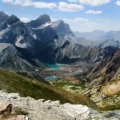China is home to some of the world’s most breathtaking national parks and mountain landscapes, where ancient history and dramatic natural beauty come together in unforgettable ways. From mist-shrouded sacred peaks and rainbow-colored valleys to towering karst formations and crystal-clear lakes, these destinations offer a glimpse into the country’s diverse geography and rich cultural heritage. Whether you’re seeking serene Buddhist retreats, enchanting forests, or otherworldly rock formations, China’s national parks and mountains invite travelers to explore extraordinary scenery and timeless wonders shaped by nature.
Tiger Leaping Gorge, Yunnan

onsuda/shutterstock
Tiger Leaping Gorge is a dramatic canyon in Yunnan Province, southwest China, carved by the Jinsha River (a major upper tributary of the Yangtze River). It lies where the river squeezes between two high snow-capped mountains: the Jade Dragon Snow Mountain (Yulong Xueshan) and the Haba Snow Mountain. Legend has it the gorge got its name because a tiger is said to have leapt across the river at its narrowest point to escape a hunter. It is one of the deepest river canyons in the world, with the drop from mountain peak to river reaching around 3,790 metres at its deepest. The landscapes are striking: sheer cliffs, roaring rapids, snow peaks overhead, steep trails and a raw sense of nature’s power. A 2 day trekking route follows the river through some of the best scenery in China.
Emei Shan, Sichuan
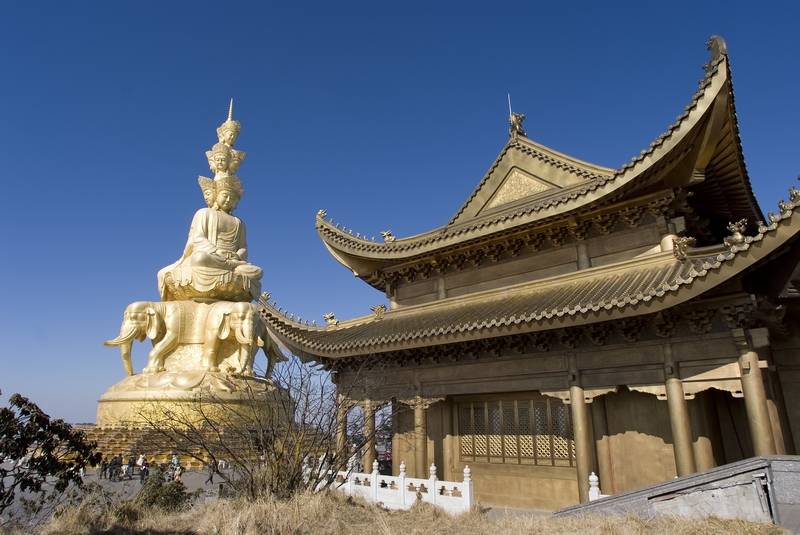
The golden summit at Emei Shan, one of the four sacred Buddhist mountains in China. It is regarded as an important place of enlightenment. teo-boon-keng-alvin/shutterstock
Mount Emei (Emei Shan), located in Sichuan Province, is one of China’s most sacred Buddhist mountains and a UNESCO World Heritage Site. Rising dramatically from lush foothills to a summit often wrapped in clouds, the mountain offers a spiritual and scenic journey through ancient temples, dense forests, and diverse wildlife. The mountain has been a center of Buddhism for over 2,000 years, and visitors encounter historic monasteries, peaceful prayer halls, and ornate statues along the pilgrimage paths. Golden Summit (Jinding), the highest peak, rewards travelers with sweeping views, a gleaming golden statue of Samantabhadra, and, on clear mornings, a sea of clouds stretching across the horizon.
Hiking Emei Shan is a rewarding experience, with well-maintained stone paths, tea houses, and rest spots along the trails. The full hike from the base to the summit typically takes 1–2 days depending on pace, though cable cars are available for those seeking a more relaxed visit. The mountain’s lower forests are known for their natural hot springs and mischievous resident macaque monkeys, while higher elevations offer tranquil temples and crisp mountain air. Whether trekking through bamboo groves, watching sunrise from the summit, or exploring centuries-old monasteries, Mount Emei combines natural beauty, cultural heritage, and spiritual tranquility in one unforgettable destination.
Kunming Stone Forest, Yunnan
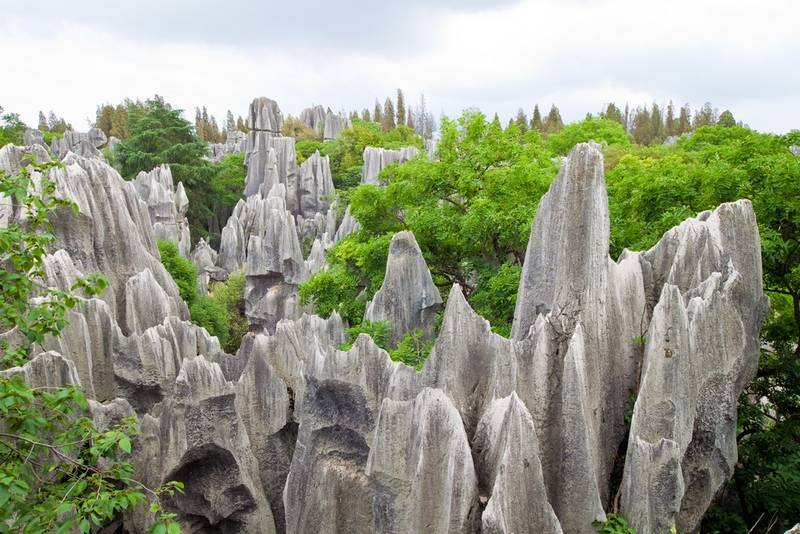
calvin-chan/shutterstock
The Stone Forest, located near Kunming in Yunnan Province, is one of China’s most unique and otherworldly natural wonders. Formed over millions of years through the erosion of limestone, this vast maze of jagged rock pinnacles rises dramatically from the earth like ancient stone trees — earning it the title “the First Wonder of the World” in China. Many formations resemble animals, towers, and natural sculptures, and local legends add a layer of romance and mystery, especially the story of Ashima, a Yi maiden turned to stone. Recognized as a UNESCO World Heritage Site, the Stone Forest offers a fascinating blend of geology, myth, and breathtaking scenery.
Visitors can explore winding paths through towering formations, tranquil pools, and lush greenery. There are both main walking routes suitable for casual tourists and quieter trails for those seeking a more contemplative experience. The site also includes cultural zones where you can learn about the traditions of the Yi ethnic minority, who call this region home and often perform vibrant dances and songs. With well-maintained facilities, viewing platforms, and guided tours available, the Stone Forest is easy to explore and can be visited as a day trip from Kunming. It’s a destination that surprises at every turn, blending natural spectacle with cultural richness.
Yangshou, Guangxi

Yangshuo, Guangxi, fuyu-liu/shutterstock
Nestled along the Li River in Guangxi Province, Yangshuo is famous for its ethereal karst mountain scenery, winding rivers, and serene rural landscapes that have inspired poets and painters for centuries. Towering limestone peaks rise above emerald rice fields, bamboo groves, and quiet village lanes, creating a dreamlike countryside that feels worlds away from city life. The town itself has a laid-back charm, with a mix of traditional architecture, lively cafés, boutique guesthouses, and a welcoming backpacker atmosphere. Many visitors come to enjoy the peaceful riverside setting, cruise along the Li River, or simply soak in the views that change beautifully with the shifting light.
Yangshuo is also a haven for outdoor adventure and cultural experiences. Cycling or e-biking through the countryside is one of the best ways to explore the region, passing local farms, karst peaks, and historic villages. You can also try bamboo rafting on the Yulong River, take part in a tai chi or cooking class, or hike up scenic viewpoints like Moon Hill for sweeping panoramic vistas. In the evenings, the famous “Impression Liu Sanjie” light show — set against the natural backdrop of the mountains — brings local folklore to life on the water. Whether seeking tranquility, recreation, or cultural immersion, Yangshuo offers a captivating blend of natural beauty and rural Chinese charm.
Jiuzhaigou Valley, Sichuan

Jiuzhaigou Valley, Sichuan, johnathan_law/shutterstock
Located in the rugged northern reaches of Sichuan Province, Jiuzhaigou Valley is a dazzling natural wonder, where crystalline lakes shimmer in turquoise and emerald hues, multi-tiered waterfalls cascade down forested slopes, and snow-capped peaks keep eternal watch. The valley covers more than 72,000 hectares and rises from around 2,000 metres up to more than 4,800 metres above sea level, creating a vast mosaic of ecosystems. It is shaped by glacial and tectonic forces and cut into three main branches—Shuzheng, Rize, and Zechawa—that form a “Y” shaped layout. Visitors wander along boardwalks and take shuttle buses through dense forests and past scenes of other-worldly beauty.
Beyond its natural splendour, Jiuzhaigou is scattered with traditional Tibetan and Qiang villages, infusing the visit with cultural richness: small wooden homes, prayer flags fluttering in mountain winds, and local crafts offering glimpses into ethnic heritage.
In terms of visiting, the valley offers both accessible highlights and more immersive experiences. Many travellers opt for a full-day loop via the sightseeing buses and boardwalks, taking in famed sites like colourful “Five Flower Lake”, “Five-Colour Pond”, “Long Lake” and the majestic “Nuorilang Waterfall”. For a deeper encounter, staying overnight nearby and exploring early-morning light over the lakes is especially rewarding.
Huanglong, Sichuan
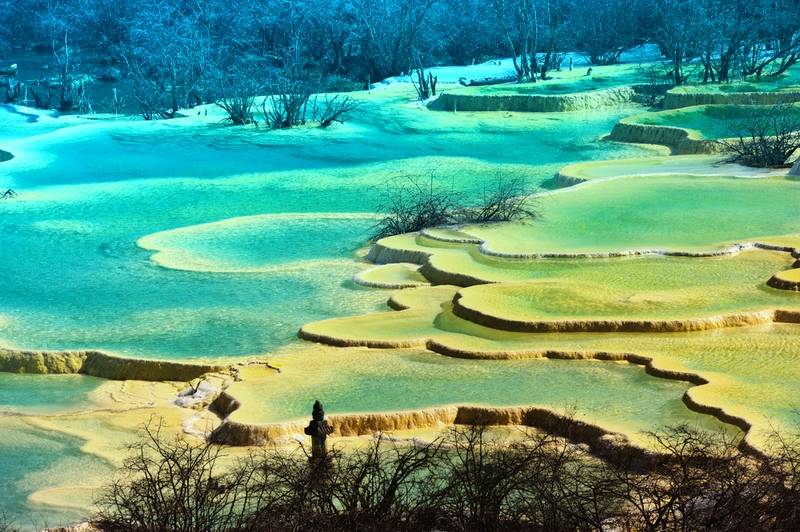
Huanglong, Sichuan, youngzg/shutterstock
Huanglong, located in the Minshan mountain range of northern Sichuan, is a stunning alpine valley renowned for its surreal terraced limestone pools, vibrant turquoise and gold colours, snow-capped peaks, and pristine forests. A UNESCO World Heritage Site, Huanglong is often described as a “fairyland on earth” thanks to its cascading pools formed by calcite deposits over thousands of years. The valley sits at high altitude, reaching over 3,500 metres, and stretches like a golden ribbon between dense woodlands and dramatic mountain scenery. Beyond the famous pools, visitors will also find serene temples, glacial peaks such as Xuebaoding, and rich biodiversity — including the endangered giant panda and golden snub-nosed monkey in the surrounding nature reserve.
Visiting Huanglong is a peaceful and awe-inspiring experience. The main scenic route follows a wooden boardwalk that leads travellers past colourful pools, waterfalls, and travertine formations all the way to the picturesque Huanglong Ancient Temple near the upper end of the valley. The walk can be challenging due to elevation, but a cable car is available to shorten the ascent and allow more time to enjoy the scenery at leisure. The best months to visit are late spring to early autumn, when the pools are most vibrant and the valley is lush, though autumn offers particularly striking colours. With its tranquil atmosphere and dreamlike landscapes, Huanglong is a perfect complement to nearby Jiuzhaigou and one of China’s most enchanting natural treasures.
Zhangjiajie National Park, Hunan
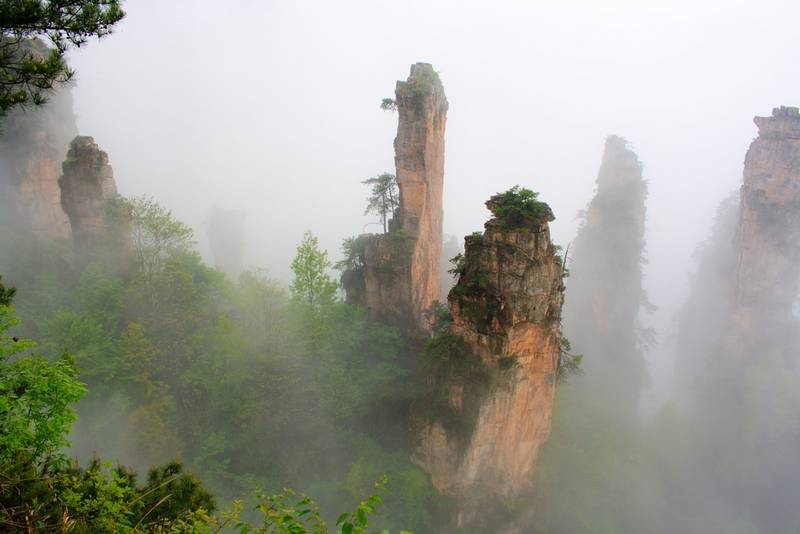
Zhangjiajie National Park, famous for its unworldly limestone formations. pavel-potseluev/shutterstock
Zhangjiajie, located in Hunan Province, is one of China’s most iconic and surreal landscapes, famous for its towering sandstone pillars that rise dramatically from misty valleys and dense subtropical forests. This otherworldly scenery served as inspiration for the floating mountains in the film Avatar, and the region’s signature quartz-sandstone formations have been shaped by millions of years of erosion. The Zhangjiajie National Forest Park forms part of the larger Wulingyuan Scenic Area, a UNESCO World Heritage Site, and offers breathtaking viewpoints, deep ravines, sparkling streams, and rich biodiversity. With over 3,000 narrow sandstone peaks, the scenery has a dreamlike quality, especially when enveloped in morning fog.
Visitors can explore this remarkable landscape via an extensive network of trails, cable cars, and glass bridges and walkways. Highlights include the famous Avatar Hallelujah Mountain, Tianzi Mountain viewing area, and the Bailong Elevator — the world’s tallest outdoor lift — which transports guests up sheer cliffs for sweeping panoramas. The nearby Zhangjiajie Grand Canyon features the dazzling Glass Bridge, suspended high above a deep gorge and offering a thrilling perspective for adventurous travellers. While the terrain looks dramatic, visiting is manageable thanks to well-maintained paths and shuttles, making it suitable for casual walkers as well as keen hikers. Zhangjiajie’s blend of natural wonder, dramatic cliffs, and atmospheric vistas makes it one of China’s most unforgettable nature destinations.
Huangshan Mountains, Anhui
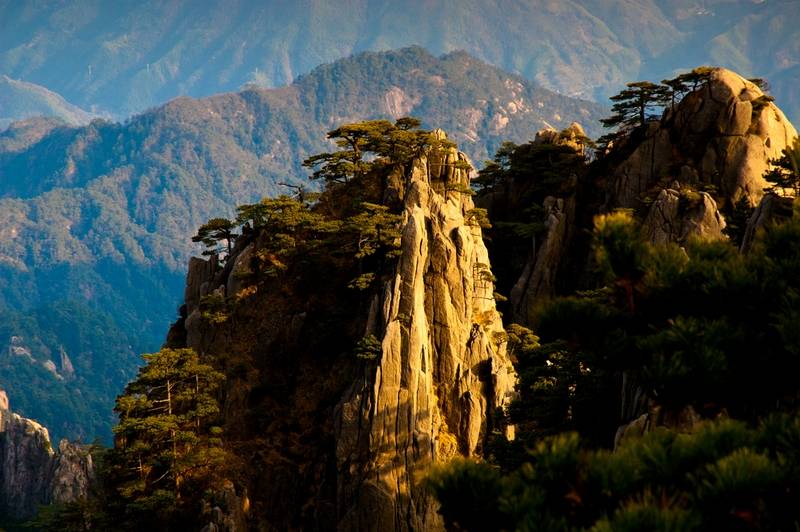
Huangshan Mountains, Anhui, There are 60,000 stone steps carved into the mountain. adolph/shutterstock
Huangshan, or Yellow Mountain, in Anhui Province is one of China’s most celebrated natural wonders and a long-standing muse for poets, scholars, and painters. Famous for its “Four Wonders” — oddly shaped granite peaks, ancient pine trees, hot springs, and seas of drifting cloud — the mountain offers a mystical, almost dreamlike landscape. Weathered peaks pierce through swirling mist, gnarled pines cling to sheer cliffs, and sunrise often paints the sky in brilliant hues above the billowing clouds. Recognized as a UNESCO World Heritage Site, Huangshan blends dramatic scenery with centuries of cultural significance, featuring stone steps carved into mountainsides and poetic names for viewpoints that reflect the mountain’s artistic heritage.
Exploring Huangshan is both inspiring and accessible, with well-maintained trails, cable cars, and a range of scenic loops suited to different fitness levels. Many travellers choose to stay overnight in mountaintop hotels to experience both sunrise and sunset — two of the mountain’s most magical moments. Key areas include the West Sea Grand Canyon, Bright Summit Peak, and the atmospheric “Flying-Over Rock”. The nearby ancient villages of Hongcun and Xidi make excellent additions to a Huangshan trip, offering preserved Ming- and Qing-era architecture and charming water-village scenery. Whether hiking through pine-lined paths, photographing golden light breaking through mist, or simply soaking in the peaceful mountain air, Huangshan promises a soul-stirring journey into one of China’s most iconic landscapes.



